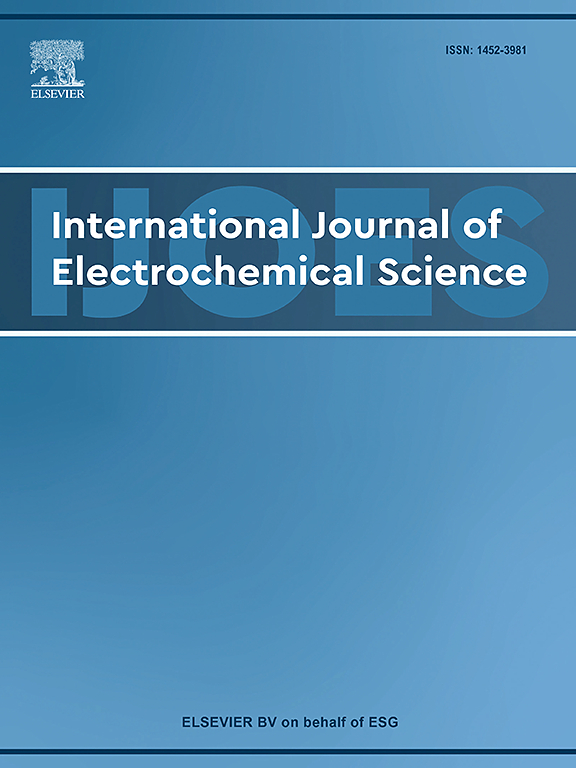Electrochemical study of the effects of additives and pH on the pulse-electrodeposition of high molybdenum content Ni-Mo alloys
IF 1.3
4区 化学
Q4 ELECTROCHEMISTRY
International Journal of Electrochemical Science
Pub Date : 2025-04-23
DOI:10.1016/j.ijoes.2025.101044
引用次数: 0
Abstract
To achieve ultrahigh hardness in Ni-Mo binary alloy, it is essential to maximize the incorporation of Mo while avoiding the emergence of intermetallic secondary phases. In the present paper, pulse current electrodeposition was employed to synthesize a Ni-Mo single-phase solid solution with elevated molybdenum content. This was accomplished by systematically optimizing the bath composition, including sodium molybdate concentration, additive selection, and pH adjustment, within a Ni-rich aqueous sodium citrate solution. It is demonstrated that inclusion of saccharin and 2-butyne-1, 4-diol as additives adversely affects the Mo atomic percentage in the Ni-Mo deposit. This is attributed to the intensified adsorption competition between additive molecules and the ternary intermediate ions on the cathode surface during the off-time of pulse current electrodeposition, as corroborated by in situ layer formation analysis using an electrochemical quartz crystal microbalance. Nevertheless, by modulating the pH value towards 7.7 through the controlled ammonia solution in the bath, the concentration of the ternary intermediate precursors was progressively enhanced. This optimization facilitated the successful synthesis of a supersaturated solid solution with a composition of Ni-26 at% Mo. An unprecedented hardness up to 12.8 ± 0.4 GPa can be achieved in this high-molybdenum Ni-Mo alloy through appropriate annealing.
添加剂和pH对高钼镍钼合金脉冲电沉积影响的电化学研究
为了使Ni-Mo二元合金达到超高硬度,必须最大限度地增加Mo的掺入量,同时避免金属间二次相的产生。本文采用脉冲电流电沉积法制备了高钼含量的Ni-Mo单相固溶体。这是通过系统地优化浴液组成来完成的,包括钼酸钠的浓度、添加剂的选择和pH值的调整,在一个富含镍的柠檬酸钠水溶液中。结果表明,添加糖精和2-丁烯- 1,4 -二醇对镍钼镀层中Mo原子率有不利影响。这是由于在脉冲电流电沉积的休息时间,添加剂分子和三元中间离子在阴极表面的吸附竞争加剧,使用电化学石英晶体微天平的原位层形成分析证实了这一点。然而,通过控制浴液中的氨溶液将pH值调节到7.7,三元中间体前体的浓度逐渐增强。这一优化有助于在% Mo下成功合成Ni-26 组成的过饱和固溶体。通过适当的退火,这种高钼Ni-Mo合金的硬度可达到前所未有的12.8 ± 0.4 GPa。
本文章由计算机程序翻译,如有差异,请以英文原文为准。
求助全文
约1分钟内获得全文
求助全文
来源期刊
CiteScore
3.00
自引率
20.00%
发文量
714
审稿时长
2.6 months
期刊介绍:
International Journal of Electrochemical Science is a peer-reviewed, open access journal that publishes original research articles, short communications as well as review articles in all areas of electrochemistry: Scope - Theoretical and Computational Electrochemistry - Processes on Electrodes - Electroanalytical Chemistry and Sensor Science - Corrosion - Electrochemical Energy Conversion and Storage - Electrochemical Engineering - Coatings - Electrochemical Synthesis - Bioelectrochemistry - Molecular Electrochemistry

 求助内容:
求助内容: 应助结果提醒方式:
应助结果提醒方式:


